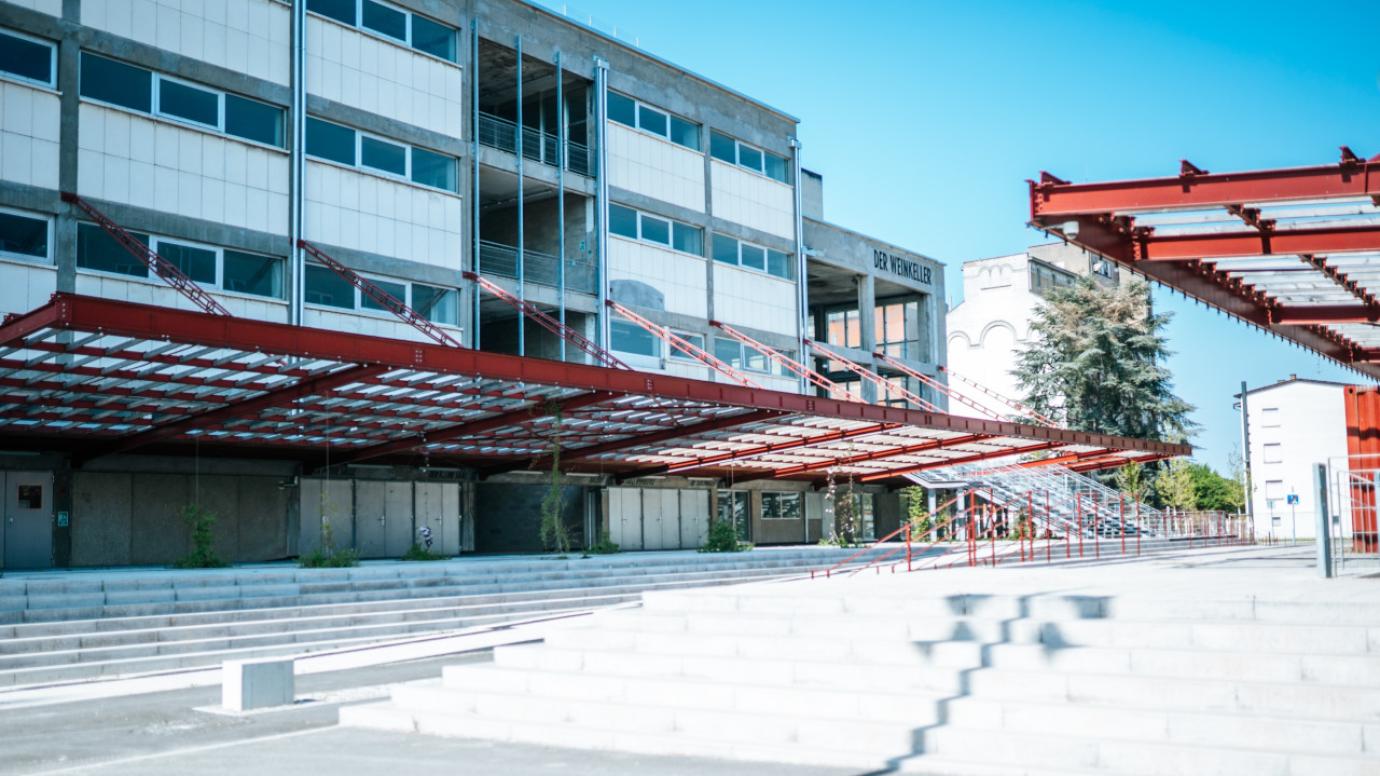Strasbourg: the COOP project
A new district to live and work cross-border.
- Country:
-
 France
France
- Type of project :
- Urban regeneration
- Size of city/region:
- 200 000 inhabitants to 1 million inhabitants

Key facts
Architecture studios: Alexandre Chemetoff & Associés, nunc, DRLW, Lucquet architects, AA+, Hentschel Kubler
Main sponsor: Strasbourg Eurometropole
Year completed: 2015-ongoing
Materials: upcycled materials, concrete
Total area: 80 000m2 (62% unbuilt)
City / regional background
The COOP is part of the wider Deux Rives urban development project, launched to renew Strasbourg’s ties with its neighbour city across the Rhine. The project has been designed to meet growing housing needs and to avoid urban sprawl by transforming some 230 hectares of port wasteland.
La Coop, located in the “Port du Rhin” neighbourhood, between the city centres of Strasbourg and Kehl, Germany, is an industrial part of the city formerly home to the iconic distribution network Coop Alsace (the Union of Alsace Cooperators). Built in 1911 to house the company’s headquarters, Coop Alsace developed their production and distribution activities there throughout the 20th century.
Following the cessation of Coop Alsace’s activities in the mid-2010s, the unoccupied site was acquired by Société Publique Locale (SPL) Deux-Rives, a company created in 2014 by Strasbourg City and Eurometropole to carry out construction or rehabilitation projects in the territory.
With landscape architect and urbanist Alexandre Chemetoff, SPL Deux-Rives has been transforming the buildings of the former Coop Alsace into a new COOP district: a mixed function place for exchanges between economic activities (including port, industrial, creative, digital, and social businesses), culture and civic life.
Solution
The COOP district master plan defines the framework of public spaces, architectural identity, ecological goals, urban programming, and the necessary public works. Its 2021 update reinforces climate adaptation and improves the social housing dimension and facilities for residents, based on local feedback.
Out of a total surface area of 80, 000 m², 45, 000 m² are in rehabilitation (mixing housing, offices, and public equipment), and 40, 000m² of new or rehabilitated surfaces will be dedicated to socio-economic activities (offices, workshops, craft premises, logistics activity, shops, community centre…).
COOP includes 550 housing units (of which 32% are affordable housing). The district hosts artists and creative companies, the KaléidosCOOP coworking space for social economy, the Strasbourg Museum’s Study and Conservation Centre, and will soon feature a food court, offices, and shops.
Notable premises:
-
La Cave à Vins (“the wine cellar”), a 12, 000 m² building, of which 7, 600 m² has been rehabilitated as facilities for the City of Strasbourg. It hosts vast multi-purpose spaces, supports for cultural and socio-economic projects and events.
-
La Virgule, a 4, 600 m² space renovated to create spaces for creation, innovation, and hosting events.
-
L’Union Sociale, an 8, 200 m² former storage warehouse, houses the Centre for Study and Conservation of Museums of the City of Strasbourg.
Criteria for high-quality (context, sense of place, diversity, beauty)
-
The COOP district invests and reinvents the heritage of Coop Alsace. The buildings, in a state of decay since the mi-2010s, are preserved, repaired, and reinvented. The architecture is based on the qualities of the existing and the singular identity of the site: the history of the place, the historic use of buildings, the presence of artists when COOP was still a wasteland.
-
The 1964 Cave à Vins building (then considered the most modern winery in France), has been classified as outstanding contemporary architecture by the Ministry of Culture in 2023, signifying the importance of the industrial architecture of the Coop district.
-
The people of Strasbourg are attached to the site’s heritage because it's part of the history of Alsace. There was once a Coop grocery shop in every neighbourhood, and many people in Strasbourg have relatives who worked for the Coop. The district's history was a key consideration for many residents when making their decision to move there.
Governance and management
The Deux-Rives project, and the COOP in particular, are the subject of a concerted development zone (Zone d'Aménagement Concerté) managed by the Eurometropole in conjunction with the City of Strasbourg.
The project is led by SPL Deux Rives and the landscape artist and urbanist Alexandre Chemetoff. The SPL Deux-Rives has a team of around twenty people dedicated to the urban project.
Strasbourg Eurometropole’s Vice-President in charge of operational urban planning, chairs a steering committee that includes all the elected representatives concerned.
Within the Administration, the Urban Development Projects Department of the Urban Planning and Territories Directorate is responsible for overall coordination. A project manager acts as the interface between the elected representatives, the departments and the operator in charge of implementing the project, SPL Deux-Rives.
The project manager works full time on the operation at the Eurometropole and City of Strasbourg, supported by a project team of 4 people (one full-time equivalent). Other departments are also involved in their respective areas of expertise.
Budget and financing
Total budget: €283 million for the Deux-Rives project, of which €51 million was allocated to the COOP project specifically.
61.7% of the development expenses (studies, land management, depollution, installation of networks and infrastructure, construction of facilities, etc.) are covered by the sale of land to property operators.
Other funding sources include:
-
Municipality/Metropolis: 38%
-
Region: 0.2%
-
National Administration: 0.1%
Transferable ideas
Tips from the city:
- Commission a study of the existing situation to guide the programming based on the past life of the site.
- Take time and leave room for the plan and the project to evolve.
- Approach rehabilitation with a certain frugality. This will help tenants to take greater ownership of the site: it enhances the value of what already exists and leaves room for future uses.


